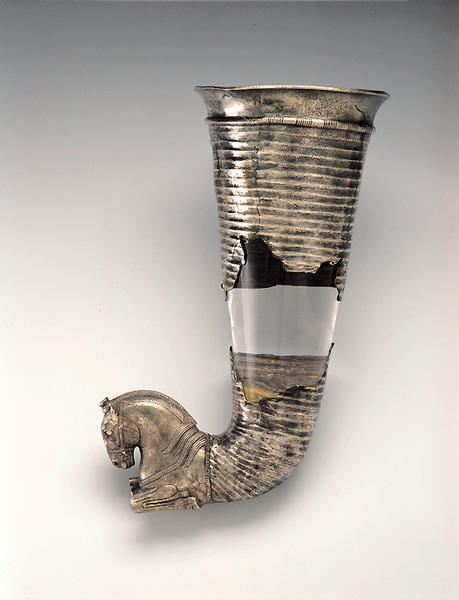馬形リュトン
- イラン北西部/アナトリア東部
- アケメネス朝ペルシア
- 前5-前4世紀初期
- 銀
- H-27 D-13
このリュトンは水平の溝が切られている部分と馬の前半身を表わした部分とで構成され、その馬の前半身の頭部に立つ髷や、首の付け根に近い部分に伸びた鬣の意匠など、あたかもペルセポリスの宮殿の壁面レリーフから飛び出して来たよう
な特徴を持っている。
ペルシャのはじまり
紀元前7世紀末から6世紀初頭にかけて、メソポタミアの最大の帝国アッシリアとその最大のライバル、ウラルトゥは、あいついで北西イランのメディアと南メソポタミアのバビロニアの同盟勢力のもとに降り、更にそのイラン系メディアは西アジア世界を初めて統一する大帝国となりました。
イラン系メディアは程なく東南イランの大きい同盟勢力であったイラン系ペルシャに取って替わられ、アケメネス朝ペルシャが立ちました。
紀元前8-7世紀のこの混沌とした時代を通じて、これらメディア、ペルシャなどのイラン民族は好戦的な神々を仰ぐ伝統的な宗教から、秩序と正義そして平和をもたらす世界の救世主をあおぐゾロアスター教に急速に転向して行きました。
彼らは世界を善悪の対立としてとらえ、最終的に善の勝利としての審判が到来するとする終末論から、現実の世界の変容を求めました。
それは絶対善の創造神アフラ・マズダーのもとに統一された世界、アフラ・マズダーから多くの者の中の唯一の王となされた王を頂く巨大帝国をつくりあげることであったと言えます。
Mary Boyce/ A History of Zoroastrianism/ Leiden I- 1996-172ff. , II- 1982- 105 ff.
ペンダント付トルク
宝飾品ー腕輪、トルク、イヤリング、首飾、指輪印章他
有翼獣文様鉢
鴨装飾ブレスレット
鴨装飾ブレスレット
帝王闘争文様鉢
獅子頭形杯
二頭の馬浮彫
ライオングリフィン形リュトン
メディア人従者浮彫
帝都建設の銘文
――そして此は私がスサに建てた宮殿。その資材は遠方より齎された。地面を地中の岩盤まで深く掘り下げた。土を取り除くと砂利が敷き詰められ、あるところは40キュビットあるいは20キュビットに達した。宮殿はこの砂利の上に建てられたのである。地中深く掘り、砂利を敷き詰め、泥煉瓦を作る―――――これら全ての作業はバビロニア人が行った。 杉材はレバノンの山からアッシリア人がバビロンまで運び、カリア人イオニア人がスサまで運んだ。シッソ材はガンダーラとカルマニアから、ラピス・ラズリ、カーネリアンの準貴石はソグディアナから。トルコ石はホラズム、銀とエボニー材はエジプト、壁の装飾はイオニア、象牙はエチオピア(クシュ)やインドそしてアラコジア、石柱はエラムのアビラドゥから運ばれた。石職人はイオニア人、リディア人。金細工師、象嵌細工師はメディア人、エジプト人。バビロニア人は煉瓦を焼き、メディア人、エジプト人は壁を装飾した。 このスサにすばらしいものを建てんとし、すばらしいものができた。願わくばアフラマツダの神が私、父ウィスタシュパそして我が同胞をみそなわし賜わんことを。
Walter Hintz/ The Elamite Version of the Record of Darius's Palace at Susa / 1950 Journal of Near Eastern Studies Vol.IX No.1
ペンダント付トルク
宝飾品ー腕輪、トルク、イヤリング、首飾、指輪印章他
有翼獣文様鉢
鴨装飾ブレスレット
鴨装飾ブレスレット
帝王闘争文様鉢
獅子頭形杯
有翼山羊装飾ブレスレット
獅子頭装飾ブレスレット
双獅子頭装飾ブレスレット
二頭の馬浮彫
ライオングリフィン形リュトン
メディア人従者浮彫
Catalogue Entry
This rhyton originally was made in two basic parts: the horizontally ribbed horn-now missing a section in the middle-with its plain, slightly flaring rim, and the terminal in the form of a horse protome with arched neck and with forelegs tightly folded under. The mane is dressed with a roached (clipped) central crest flanked by a short fringe along either side, and the forelock is tied upright, trimmed in a stiff brush. The treatment of the forelock, as well as the four long locks remaining on either side at the withers, are typical of both ridden and driven horses in the Achaemenid period.1 The roached mane, less common, was known primarily in Achaemenid Anatolia.2 The bridle, with its simple hatched bands, consists of only a single-strap headstall, a noseband, and a throatlatch-the latter fastened on the left side in a knot. Damage in the mouth area obscures the type of bitting, but small silver spikes or posts at the joins of the headstall and the noseband on either side and at the crossings of the headstall and the throatlatch suggest that other harnessing elements were added separately. A matching hatched breast strap encircles the chest, interrupted only by the small tubular spout in the center.
Horses appear frequently in Achaemenid art, primarily in glyptic and in metalwork. The compact form and general style of the Shumei horse, as well as some details of its harnessing and adornment, find close parallels in the stone reliefs from the Apadana at Persepolis, the Achaemenid capital in central Iran.3 These similarities argue for production of the rhyton in a royal atelier as opposed to a provincial workshop. Two excavated silver horse rhyta from Arinberd in Armenia provide provincial variations on the motif.4 Silver rhyta with ribbed horns have been excavated from a tomb in the Crimea dated to the first half of the fifth century B.C.,5 but the nearest counterpart to the Shumei horse rhyton in proportion, construction, and style is a gilt-silver example unfortunately without documented provenance; reputed to have come from eastern Anatolia, this elegant rhyton with a griffin protome is now in the British Museum.6 The Shumei rhyton, perhaps a silver version of the golden vessels used by the Persian Great King, like the British Museum example, may have graced a satrap's court in Anatolia.
TSK
1. See Littauer and Crouwel 1979, fig. 80.
2. See Ghirshman 1964, p. 176; Littauer and Crouwel 1979, p. 149.
3. See Ghirshman 1964, pp. 170, 176, 178-79, 184; Roaf 1983, p. 39, pl. XII.
4. See Harper et al. 1978, p. 30, fig. 1a; Arakelian 1971, pp. 143-48.
5. See Culican 1965, pls. 55, 62.
6. No. WA 124081.
